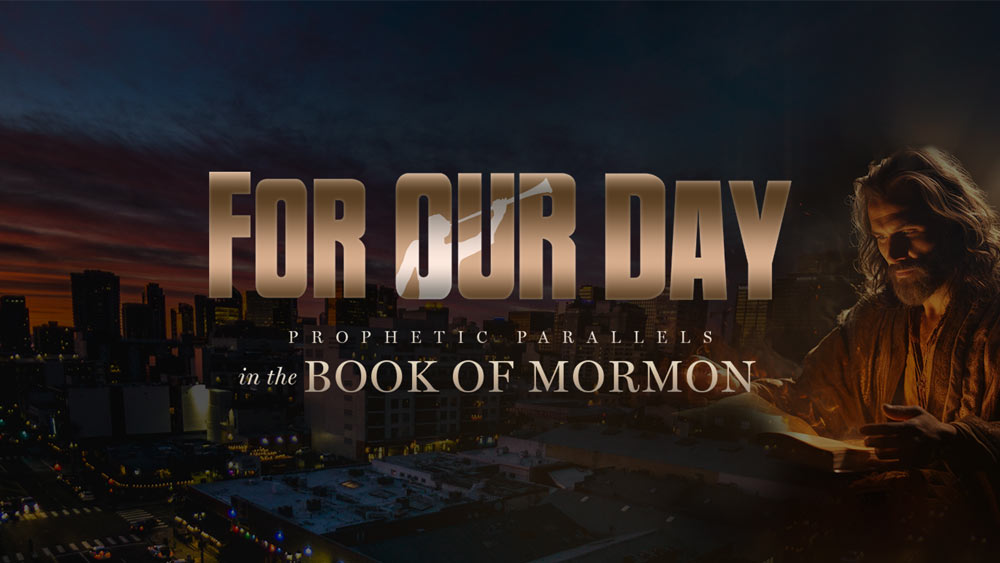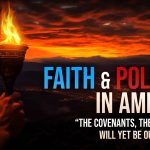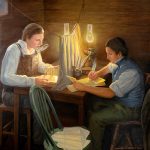Administration of President Grant — 1918-1945
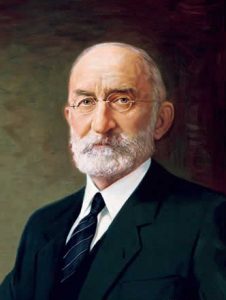
President Heber J. Grant
By virtue of his position as president of the council of apostles, Heber J. Grant became the presiding officer of the Church at the death of President Smith. Heeding the instruction of President Wilford Woodruff—which was given by revelation, and was followed by Presidents Snow and Smith—that the First Presidency should be organized without delay, the council of apostles met Nov 23, 1918, in the temple, and Heber J. Grant was sustained and set apart as President of the Church. He selected as his counselors Anthon H. Lund and Charles W. Penrose, who had served with President Joseph F. Smith.
President Grant was born November 22, 1856, in Salt Lake City. He was the son of Jedediah Morgan and Rachel Ridgeway Ivins Grant. He was a man of great activity and endless energy; full of sympathy for the down-trodden and the poor. In the financial world he was recognized as a man of keen ability, yet his life was constantly devoted to the welfare and progress of the Church, his labors in the ministry dating from his early youth. In 1880 he was called to preside over the Tooele Stake of Zion, succeeding Francis M. Lyman who had been called into the council of the twelve. Two years later (October 16, 1882) he was himself ordained an apostle, having been called, with Elder George Teasdale, to that office by revelation. In 1901 he went to Japan and there opened the door for the preaching of the Gospel, and after his return he was called to preside over the European mission, where he labored for three years.1
The General Conference Postponed
Because of the influenza epidemic no meetings were held during the winter and spring of 1919. On this account, the general conference, which otherwise would have been held in April, was postponed until June 1, 1919. On that occasion the solemn assembly of the Priesthood was held, and the authorities of the Church were sustained by the usual separate vote of the quorums. That conference was devoted largely to a memorial service for President Joseph F. Smith.2
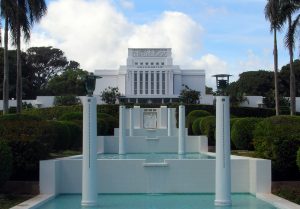
Dedication of the Hawaiian Temple
Thanksgiving day, November 27, 1919, the temple at Laie, Hawaii, was dedicated by President Heber J. Grant. He was accompanied to that land by President Anthon H. Lund, Rudger Clawson, Stephen L Richards, Presiding Bishop Charles W. Nibley and Arthur Winter. The dedicatory services were repeated, five services being held to accommodate all the people—1,239 souls attending the services. This is the first temple erected outside of the continental United States, and is for the benefit of the native Saints of the islands of the Pacific. The mission in the Hawaiian Islands was opened in 1850 by George Q. Cannon and others, and thousands of the natives received the Gospel. The site for the Hawaiian temple was dedicated by President Joseph F. Smith, June 1, 1915.3
Passing of President Lund—Changes in the Presidency
After a brief illness, President Anthon H. Lund first counselor in the first presidency, passed away at his home in Salt Lake City, March 2, 1921. He served in the presidency during the entire ministry of President Joseph F. Smith, having been chosen second counselor in October, 1901. After the death of John R. Winder, the first counselor, he was advanced to that position in April, 1910. President Lund was a man without guile, faithful and true to the Gospel and to the brethren, and beloved by all the Saints.
At the meeting of the council of the presiding authorities held in the Salt Lake Temple, Thursday, March 10, 1921, President Charles W. Penrose was chosen by President Heber J. Grant as his first counselor, and Elder Anthony W. Ivins as his second counselor. Rudger Clawson was at the same time set apart as president of the twelve apostles, as he became the ranking apostle after the death of President Lund.4
The General Conference of April, 1920
At the general conference of the Church held in April, 1920, the one hundredth anniversary of the Prophet’s vision of the Father and the Son, was fittingly observed. Remarks by the brethren had a bearing upon the great work accomplished by the Prophet Joseph Smith, and the authenticity of his story. The Improvement Era, organ of the priesthood quorums and of the Young Men’s Mutual Improvement Associations, devoted the April number to special articles dealing with the theme of the Vision. Other magazines did the same. A cantata by Evan Stephens, which was prepared for the occasion, was presented before a crowded house in the Tabernacle, and special topics were considered in the wards throughout the Church following the April Conference.5
Progress of the Church
Ninety years before (1830) the Church was organized with but six members. In 1920, it numbered several hundred thousands. Its property in meeting houses, tabernacles, temples and other structures, was valued at many millions of dollars. There were 83 stakes of Zion, 871 organized wards and 83 independent branches within the stakes. Missionary work had been carried to various parts of the earth, and there were 24 missions regularly established with numerous conferences (later called districts) and branches. The total number of men holding the Melchizedek Priesthood was 57,600, and the total number holding the Aaronic Priesthood was 49,780. Thousands of young people were actively engaged in the auxiliary organizations of the Church, and it was conceded by many ministers of other churches that the “Mormon” Sunday Schools were the best that could be found in all the world. 6
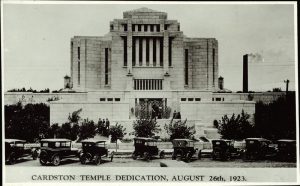 Dedication of the Alberta Temple
Dedication of the Alberta Temple
July 27, 1913, President Joseph F. Smith dedicated the ground for the building of a temple at Cardston, Canada. September 19, 1915, Elder David O. McKay laid the corner stone of the building, and the capstone was laid September 23, 1917. The building, one of the most elaborate and beautiful of the temples, was dedicated by President Heber J. Grant, August 26, 1923. The Services of dedication began at 10:00 A.M. August 26, and continued until the afternoon of Wednesday, August 29th, eleven sessions in all being held, most of the general authorities and many thousands of Latter-day Saints attending them.7
Celebration at the Hill Cumorah and the Sacred Grove
September 21 to 23, 1923, a solemn celebration was held at the Smith Farm, the Sacred Grove, and the Hill Cumorah, in New York State. The occasion was the one hundredth anniversary of the coming of the Angel Moroni to the Prophet Joseph Smith. President Heber J. Grant and a number of the general authorities of the Church were present. Elder B. H. Roberts, who was then presiding over the Eastern States Mission, was in attendance with all his missionaries and many of the Saints were also present. Addresses were made by the leading brethren and a program of speaking, music and prayer, featured the celebration. Many strangers, as well as the members of the Church, were deeply impressed and some of the newspapers gave accurate and sympathetic accounts of the meetings and of the mission of the Prophet Joseph Smith.8
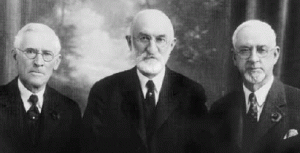
Death of President Penrose—Changes in the First Presidency
President Charles W. Penrose, first counselor to President Heber J. Grant, died May 16, 1925, in Salt Lake City. President Penrose had served as a counselor to President Joseph F. Smith from December, 1911, until the death of President Smith. He then served as second counselor to President Heber J. Grant until the death of President Anthon H. Lund, when he was advanced to the position of first counselor and Elder Anthony W. Ivins of the council of the apostles was chosen as second counselor in the First Presidency. Following the death of President Penrose, President Ivins was advanced to the position of first counselor and Charles W. Nibley, who was at the time the presiding bishop of the Church was chosen by President Grant as his second counselor. This necessitated choosing of a presiding bishop and Elder Sylvester Q. Cannon, president of the Pioneer Stake, was called and ordained to that position. Bishop Cannon selected the same counselors who had served with Bishop Nibley, namely David A. Smith and John Wells.9
Dedication of the Arizona Temple
November 28, 1921, President Heber J. Grant dedicated a site for a temple at Mesa, Arizona, in the presence of about three thousand people. The work of construction commenced shortly after on the building which was finished in due time, but was not dedicated until Sunday, October 23, 1927. On that day President Heber J. Grant offered the prayer of dedication in a solemn assembly of Saints. As was done in the dedication of other temples, several sessions were held that the multitudes of people might attend. The prayer was repeated each meeting. These meetings commenced on the morning of the 23rd of October and continued until the 27th, three sessions being held each day except on the 27th when one session was held. Most of the general authorities of the Church were in attendance and took part in the services.10

Purchase of the Hill Cumorah and the Whitmer Farm
The farm formerly owned by Peter Whitmer, Sen., in Fayette, Seneca County, New York, was purchased by the Church September 25, 1926. It was at the home of Peter Whitmer, Sen., on this farm that the Church was organized April 6, 1830, and where the latter part of the Book of Mormon was translated. In the year 1923 a portion of the Hill Cumorah on the western slope came into the possession of the Church by purchase. February 18, 1928, the Church purchased from the estate of Pliny T. Sexton of Palmyra, New York, the rest of the Hill with adjacent farm lands and in this way the full possession of this sacred spot also came into the possession of the Church. The Hill Cumorah and the Whitmer Farm are two of the outstanding landmarks of greatest interest to Latter-day Saints because of their importance in connection with the establishing of the great work of the Lord in this dispensation of the Fulness of Times.11
Centennial Celebration
The One Hundredth Annual Conferencc of the Church convened in the Tabernacle, Salt Lake City, Sunday April 6, 1930, and continued until the afternoon of Wednesday, the ninth. This being the centennial anniversary of the organization of the Church, special and appropriate services were arranged for the conference. A pageant entitled, The Message of the Ages, was presented in the Tabernacle. The pageant commenced on the night of April 6, 1930, and continued without interruption for thirty nights. Hundreds of thousands of people attended these performances, the time being divided among the stakes. People from all parts of the earth were in attendance, and the impressions made upon them were very favorable to the Church. The Latter-day Saints who came to the conference outnumbered those present at any previous gathering. The proceedings of the sessions of the general conference were broadcast by radio over station KSL, Salt Lake City.12
Repeal of the Eighteenth Amendment
In the year 1918, the people of the United States amended the Constitution of the United States prohibiting the manufacture, possession and sale of liquor. Immediately following this action the liquor interests of the country commenced a vigorous campaign to bring about the repeal of this amendment. Propaganda was carried on vigorously through the press and the people were made to believe that the condition under prohibition was worse than before the amendment was adopted. In the general election of 1933, enough states voted for repeal to make such action effective. Utah, contrary to the wishes of the General Authorities of the Church, joined with the majority of the states in demanding repeal, and the Beehive State held the doubtful, if not disgraceful, position of being the thirty-sixth state of the Union to hold a constitutional convention and thus brought about ratification of repeal. Since that action liquor has been flowing freely throughout the land, crime and drunkenness have increased and the sale of liquor and tobacco has become an outstanding menace to our youth. At this election Senator Reed Smoot, who had served in the Senate for thirty years, was defeated in a wave which swept over the country placing the opposite party into power.13
Changes in the First Presidency
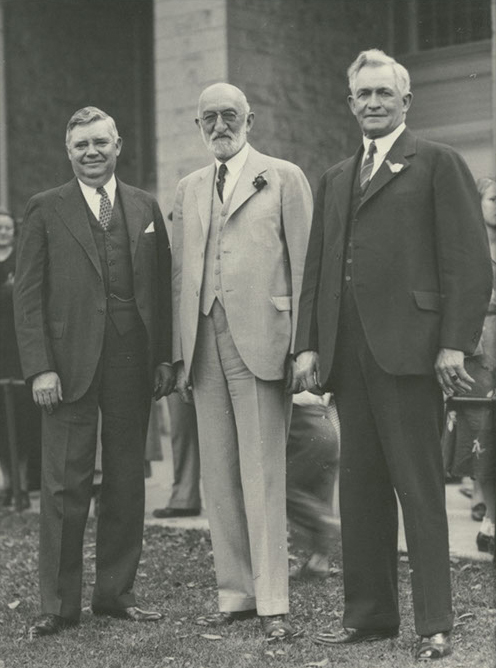
President Charles W. Nibley, second counselor in the First Presidency, died Dec. 11, 1931, and at the general conference, April 6, 1933, Elder J. Reuben Clark, Jr., was sustained as second counselor to President Heber J. Grant. The delay in filling the vacancy was due to the fact that Elder Clark had been serving as Ambassador to Mexico for the United States Government until shortly before he was sustained. Sept. 23, 1934, President Anthony W. Ivins died after a brief illness, and at the general conference, October 6, 1934, J. Reuben Clark, Jr., was sustained as a member of the council of the apostles and also as first counselor to President Grant, and Elder David O. McKay, of the council of apostles, was sustained as second counselor in the First Presidency. Elder Alonzo A. Hinckley was also sustained as a member of the council of the apostles.14
Other Developments
At the beginning of the year 1935, the membership of the Church had greatly increased. There were 110 stakes of Zion, 952 wards and 82 independent branches. There were also 29 missions. The German Mission had been divided and the Swiss-German and German-Austrian Missions created in 1925. The French Mission was again opened after many years of inactivity in that land, also the Palestine-Assyrian Mission. In 1925, Elders Melvin J. Ballard of the council of the twelve, Rulon S. Wells and Rey L. Pratt of the first council of seventy, went to South America to open up a mission there. At Buenos Aires in the Argentine, December 25, 1925, Elder Ballard dedicated the land of South America for the preaching of the Gospel. The Southern States Mission was also divided and a new mission created known as the East Central States. A departure from long established custom of having an apostle preside over the British Mission and at the same time supervise the other missions in Europe, was taken, and in October, 1928, Elder August William Lund, son of President Anthon H. Lund, was chosen to preside over the British Mission, thus leaving Elder John A. Widtsoe, who was presiding over the British Mission, free to take the supervision of all the missions in Europe.15
Withdrawal of the Missionaries from the Nations
Following the armistice in November, 1918, which brought World War I to its close, the victorious nations created a number of small states n Europe and placed restriction upon the Central powers hoping that these acts would insure permanent peace for the world and make it “safe for democracy.” This plan miserably failed. Following the war Germany became a republic and elected General Paul von Hindenburg president. This form of government soon came to an end and an ambitious man named Adolph Hitler rose to power from obscurity, and in the course of a very few years obtained absolute power, subjecting the German people to his rule. Men of like character also arose in Italy and Russia, and again the peace of the world was threatened. Germany regained her military strength, broke the treaties made following the war of 1914-1918, and soon subdued some of the smaller states on her border, over the protest of England and France. During the month of August, 1939, it became very evident that Germany was about to open hostilities against Poland which caused the tension in Europe to become very grave.
On August 24, 1939, it having become apparent that war was inevitable, the First Presidency sent word that all the missionaries in Germany should be transferred to neutral countries. Acting on this advice, and under the direction of Elder Joseph Fielding Smith, who was in Europe, all the missionaries of the East German Mission were directed to go to Denmark, and all those of the West German Mission to go to Holland. As Holland refused to permit the missionaries to enter her borders, the West German missionaries were also sent to Denmark, where they were permitted to enter that land. The first intention was to distribute these missionaries among the neutral nations of Scandinavia and Holland there to continue their labors. September 1, 1939, Germany invaded Poland and on the third of September England and France declared war on Germany. Following these declarations the neutral nations of Europe made it known that they desired all foreigners to leave their borders, and the missionaries were not welcome in those lands. Because of this attitude the missionaries were instructed to leave Europe and return to the United States.
There were in the European missions at the time 697 persons, of whom 611 were young men and 63 young women missionaries; the other 23 were mission presidents, their wives and children. These missionaries returned in 23 ships, mostly freight boats which had been improvised to care for the numerous passengers returning to America. The first group arrived in New York September 7, 1939, and the last, except the mission presidents in Denmark, Norway and Switzerland, their families and secretaries, arrived in New York, November 6, 1939.
Elder Joseph Fielding Smith and wife accompanied this group. The remaining presidents in Denmark and Norway arrived a few days later and Elder Thomas E. McKay with his group of four missionaries, his wife and daughter, arrived March 4, 1940. Thus all the missionaries were withdrawn from Europe, except Elder Gaston Chappuis, a native of Switzerland, who remained in France. All returned without accident of any kind knowing that the Spirit of the Lord had guided them safely to America’s shores. As the greater number of the missionaries had not completed their missionary terms, they were met and cared for by Elders John H. Taylor of the first council of seventy and Frank Evans, President of the Eastern States Mission, and by them re-assigned to new fields of labor. As the war became more frightful and other peoples were involved, the Presidency later in the year 1940, withdrew the missionaries from South Africa and the missions of the Pacific, except Hawaii, a possession of the United States.16
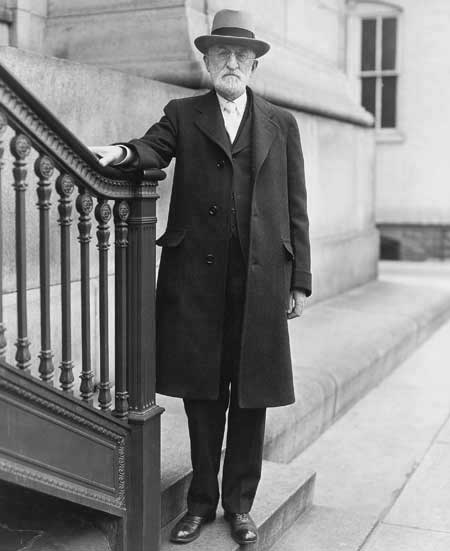
Resumption of the World War
Friday, September 1, 1939, Germany, under the dictation of Adolph Hitler, suddenly crossed the border of Poland which brought to pass a declaration of war from England and France the following Sunday, September 3rd, against Germany. These nations were woefully unprepared for war. On the other hand Germany was, as she thought, fully equipped and ready. The results in the early months of the contest saw France subdued and forced to surrender and placed under drastic terms and heavy burdens, June 20, 1940. At this time the British soldiers in France were driven out of France, and a short time later off the European continent. On April 9, 1940, Germany, without any warning, invaded Norway, and on the 10th of May, invaded Holland with a sudden attack that left cities waste and thousands of her people murdered. Continuing this conquest, a great portion of which had previously been accomplished by threats of force in Austria, the Balkans and Slovakia, Germany took over most of France, all of Denmark, Belgium and Norway. In this dark hour, June 10, 1940, Italy, thinking the war was practically over and wishing to partake of the spoils, declared war on England and France. However, England was not defeated and continued the fight, refusing the terms offered for surrender from what was called the axis powers. September 27, 1940, Japan joined the axis powers signing a ten year tri-partite pact in Berlin.
June 22, 1941, Germany, feeling that Russia was a threat on her eastern border, and evidently feeling that in that country she could continue her easy conquest, invaded Russia and with rapid strides was soon threatening the gates of the Russian capital on the north and Stalingrad on the west, on the borders of the Black Sea, but at this point the Russians held firmly and stopped the German advance. Germany and Italy, however, had taken possession of Albania and Greece and islands in the Mediterranean and Aegean seas, and had driven the British in Africa beyond the borders of Egypt and were threatening to take possession of the Suez Canal and the passage to the East.
December 7, 1941, Japan made a sudden attack on Pearl Harbor, on the island of Oahu, Hawaii, destroying, or disabling many of the warships of the United States. The following day the Congress of the United States declared war on Japan, and on the 11th, Germany and Italy declared war on the United States, and thus, in fulfillment of the revelation on war, again war was to be poured out on all nations. Japan immediately took possession of the islands of Guam, Midway, and Wake, and after a bitter and heroic struggle drove the small American force out of the Philippines. From this time on, however, the tide began to turn. In November 1942, the American and British forces invaded North Africa, and the British forces in Egypt began to force back the opposing forces until between the army on the west and the army on the east, the German and Italian armies were driven out of Africa. Immediately the allies, as America and Britain with such help as they received were called, invaded Sicily and then Italy, making remarkable progress against Italian and German forces. On September 8, 1943, Italy was forced to surrender.
In the most bitter struggle the world has ever seen, in the midst of blood and carnage, destruction of cities and the taking of millions of lives, including innocent women and children and entire inhabitants of cities and villages, by the dropping from the air of bombs and the shooting of what have been called “robot” bombs weighing many tons, the inhabitants have been called upon to mourn. The cruelty, murders, destruction of lives and property have been too appalling to possibly describe. June 6, 1944, the American and British forces invaded Normany, and after a bitter struggle and the loss of hundreds of thousands of men, gradually forced the Germans back beyond their own borders in the West, while in the East the Russians accomplished the same result, until eventually the two forces met and the city of Berlin was in ruins. It was not until then, and when the axis powers were left powerless to continue the struggle, that the German armies were overcome and forced to grant an unconditional surrender. In the meantime the German plotters who had started the conflict either were captured, killed themselves, or went into hiding where they could not be found. May 8, 1945, the announcement was officially made that Germany had surrendered. Property estimated as worth billions had been destroyed. Millions of lives were sacrificed, the inhabitants of cities and villages ruthlessly murdered. Shipping on the seas became extremely dangerous because of the activity of German submarines, and the loss by sea became appalling. The full extent of the evil created by this conflict will never be known by mortal man. All of this destruction has come about because man has forsaken his Maker and rejected his Redeemer, and turned to his own strength aided in his selfish ambitions by the great deceiver and enemy of all righteousness.

After the surrender of Germany the struggle in the far east with Japan continued. Gradually the Allied forces made inroads into the possessions near the main islands of Japan and recaptured Manila and a large portion of the Philippines. The air force of the United States carried the warfare over the cities of Japan with devastating results. Two large cities, Hiroshima and Nagasaki were destroyed by the dropping of atomic bombs, the most horrifying and dreadful means of destruction ever witnessed in warfare. The secret formula for these bombs was prepared in the United States and released atomic energy of untold destructive power. Naturally the enthusiasm for war and conquest by the Japanese was dampened and their ardor cooled by the surrender of Germany. Moreover their supplies for carrying on war were rapidly diminishing; these together with the terrible destruction that had overtaken them and which still awaited them, caused that nation to sue for peace and Japan surrendered September 2, 1945. After more than five years of the most horrible bloodshed and destruction in which millions of lives were sacrificed and billions in value of property destroyed, the world found itself sick and feeble spiritually, mentally and morally. However the end of hostilities did not bring to the world peace. The unrest, bickerings and disagreements among the nations still go on. At the present writing delegates from the nations are in solemn conclave endeavor to work out some sort of world system of United Nations, upon which there may be universal agreement that will end war. It is very apparent that such efforts will eventually fail, for there is only one principle upon which such universal peace can come; that is an acceptance of the saving principles of the Gospel of Jesus Christ and this the world is not willing to do. When selfishness and ambition for power dominate the hearts of men and nations, there can come no permanent peace. Moreover, we know, for the Lord has revealed it, there will be no peace until the Prince of Peace comes and brings it and cleanses the earth of its iniquity.

If men would only remember their Redeemer and serve him, then he would come to their aid and fight their battles, but they have placed their strength in their own puny arms. Surely we may, and should, pray that the Prince of Peace may come speedily and hearken to the pleadings of mother earth that she be cleansed of all the filth that has gone forth upon her face that she may rest, and once again the glad tidings of the Gospel go forth to all the humble in every nation, kindred and tongue and people.17
Church Progress
In the spring of the year 1945, there were 149 stakes of Zion, 1150 wards, 128 independent branches and 35 dependent branches in the stakes. * * * There were in the stakes of Zion 89,106 men and boys enrolled in the Aaronic Priesthood and in the missions 15,547. There were also in the stakes 112,850 men enrolled in the Melchizedek Priesthood and 9,730 in the missions. The proclamation of the Gospel had been made in nearly all parts of the earth and had been brought to the attention of kings, presidents, potentates and rulers. At the close of the year 1944 there were many signs given spoken of by our Lord as presaging his second coming. The “fig trees” of prophetic warning were rapidly putting forth their leaves, showing that the summer of the Lord’s coming “was nigh at hand.” “For,” said the Lord, “in my own due time will I come upon the earth in judgment, and my people shall be redeemed and shall reign with me on earth. For the great Millennium, of which I have spoken by the mouths of my servants, shall come. For Satan shall be bound, and when he is loosed he shall reign for a little season, and then cometh the end of the earth. And he that liveth in righteousness shall be changed in the twinkling of an eye, and the earth shall pass away so as by fire.” It also appeared that the prophecy of Isaiah was about to be fulfilled:
“Go through, go through the gates; prepare ye the way of the people; * * * lift up a standard for the people.
“Behold the Lord hath proclaimed unto the end of the world, Say ye to the daughter of Zion, Behold, thy salvation cometh, behold, his reward is with him, and his work before him.
“And they shall call them, The holy people, The redeemed of the Lord; and thou shalt be called, Sought out, A city not forsaken.” 1819
The Passing of President Heber J. Grant
In the late afternoon May 14, 1945, President Heber J. Grant, peacefully passed away at his residence in Salt Lake City. He had been ailing for the past five years, but his courage and determination to press on and perform his duty, never deserted him. Each day, up to a short time before his death, he was found at the office attending to duties as much as the physician permitted him to do. His life had been one of great activity. In his early years he appeared frail, was rejected for insurance, because of his physical condition, however, he had been active always, engaging in athletics, one time belonging to the champion baseball team of Utah. His energy was marvelous and his activities never ceased. There was never any compromise on his part with evil. Some of his strongest characteristics the public never realized. He had a tender, sympathetic nature, loved his friends dearly; was kind to the distressed; assisted the needy scores upon scores of times, the knowledge of which never got into any earthly record. His testimony of the Truth never wavered. His friends were legion outside of the Church, and he was dearly loved by his people.
The funeral services were held Friday, May 18th, and were attended by the greatest gathering ever assembled in Utah on any such occasion. As the cortege passed thousands stood in the streets for many blocks with bowed heads. He was honored by representatives of other Churches and the bell of the Catholic Cathedral tolled, and nurses stood at attention as the procession passed. Men of renown from distant parts came to do him honor, many of the stores in the city closed their doors and there was a general mourning because a mighty man had been taken home after a long and eventful life of more than 88 years.20
- Essentials in Church History. Joseph Fielding Smith, pg. 519
- Ibid. pg.520
- Ibid. pg.520-521
- Ibid. pg.521
- Ibid. pg.521-522
- Ibid. pg.522
- Ibid. pg.522
- Ibid. pg.522-523
- Ibid. pg.523
- Ibid. pg.523
- Ibid. pg.524
- Ibid. pg.524
- Ibid. pg.524-525
- Ibid. pg.525
- Ibid. pg.525
- Ibid. pg.526-527
- Ibid. pg.527-529
- Isa. 62:10, Isa. 62:11, Isa. 62:12, Isaiah 62:10-12
- Ibid. pg.530
- Ibid. pg.530-531


